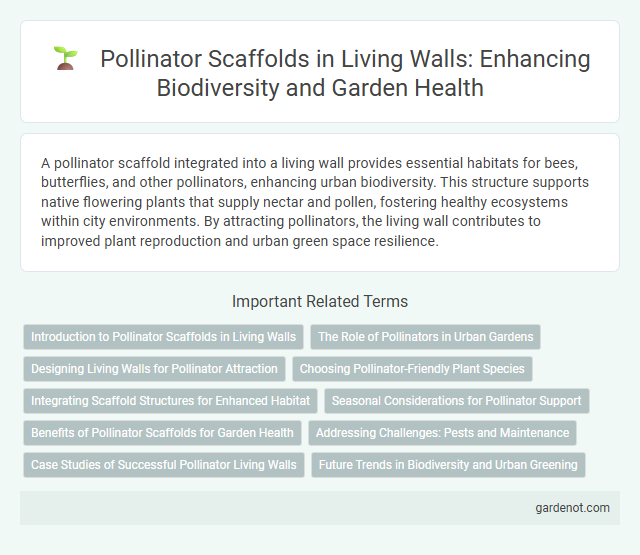A pollinator scaffold integrated into a living wall provides essential habitats for bees, butterflies, and other pollinators, enhancing urban biodiversity. This structure supports native flowering plants that supply nectar and pollen, fostering healthy ecosystems within city environments. By attracting pollinators, the living wall contributes to improved plant reproduction and urban green space resilience.
Introduction to Pollinator Scaffolds in Living Walls
Pollinator scaffolds in living walls create essential habitats that support bees, butterflies, and other pollinators by integrating flowering plants tailored to local ecosystems. These structures enhance biodiversity and improve pollination efficiency in urban environments, contributing to sustainable green infrastructure. Implementing pollinator scaffolds promotes ecological balance and fosters stronger plant-pollinator interactions within vertical garden systems.
The Role of Pollinators in Urban Gardens
Pollinator scaffolds enhance urban gardens by providing structured habitats that support bees, butterflies, and other crucial pollinators, directly improving plant reproduction and biodiversity. These living walls promote ecological balance and increase the yield of flowering plants by facilitating efficient pollination in dense city environments. Integrating pollinator-friendly plants within vertical gardens boosts urban green spaces' resilience and overall ecosystem health.
Designing Living Walls for Pollinator Attraction
Designing living walls for pollinator attraction involves selecting native flowering plants that provide continuous nectar and pollen sources throughout the seasons. Incorporating a diverse range of plant species with varying bloom times maximizes habitat suitability for bees, butterflies, and other pollinators. Structural considerations include optimal sun exposure, moisture retention, and easy access for pollinators, ensuring the living wall functions as an effective pollinator scaffold.
Choosing Pollinator-Friendly Plant Species
Selecting pollinator-friendly plant species for a living wall enhances biodiversity and supports essential pollinators such as bees, butterflies, and hummingbirds. Native flowering plants like milkweed, coneflowers, and bee balm provide vital nectar and pollen resources while improving plant resilience and ecological balance. Incorporating a variety of bloom times ensures continuous food supply throughout the growing season, promoting robust pollinator populations.
Integrating Scaffold Structures for Enhanced Habitat
Integrating pollinator scaffold structures into living walls significantly boosts habitat complexity, providing essential support for pollinators like bees, butterflies, and hummingbirds. These scaffold frameworks optimize vertical and horizontal space, enabling diverse native plant species to thrive and offer continuous nectar and pollen sources. Enhanced habitat connectivity within urban environments promotes ecosystem resilience, supporting pollinator population growth and biodiversity conservation.
Seasonal Considerations for Pollinator Support
Pollinator scaffold living walls require careful seasonal planning to provide continuous floral resources and habitat throughout the year, supporting diverse pollinator species across different life cycles. Selecting native, seasonally blooming plants ensures nectar and pollen availability from early spring to late fall, enhancing pollinator foraging opportunities during critical periods. Proper timing of plant maintenance and replacement maximizes habitat stability, contributing to stronger pollinator populations and overall ecosystem resilience.
Benefits of Pollinator Scaffolds for Garden Health
Pollinator scaffolds enhance garden health by providing structured habitats that support diverse pollinator species, increasing pollination efficiency and plant reproduction rates. These scaffolds contribute to improved biodiversity, fostering resilient ecosystems and reducing the need for chemical fertilizers or pesticides. Incorporating pollinator scaffolds into living walls promotes continuous pollinator activity, boosting overall plant growth and garden productivity.
Addressing Challenges: Pests and Maintenance
Pollinator scaffold living walls integrate pest-resistant plant species and modular components to minimize infestations and simplify upkeep. Advanced irrigation systems and targeted biological controls reduce pest populations without harming pollinators, ensuring a healthy ecosystem. Maintenance is streamlined through accessible panel design, allowing efficient inspection and replacement while preserving habitat stability.
Case Studies of Successful Pollinator Living Walls
Pollinator scaffold living walls have demonstrated significant ecological and aesthetic benefits in urban environments, as seen in projects like the Montreal Biodome and London's Barbican Centre. These walls incorporate native flowering plants that attract and support diverse pollinator species, including bees, butterflies, and hummingbirds, enhancing local biodiversity and improving air quality. Studies reveal that such installations increase pollinator visitation rates by up to 40%, contributing to urban ecosystem resilience and sustainability.
Future Trends in Biodiversity and Urban Greening
Pollinator scaffolds enhance biodiversity by providing essential habitats for bees, butterflies, and other pollinators in urban environments. Integrating these structures into living walls supports ecological connectivity and promotes native plant growth, aiding urban greening initiatives. Future trends emphasize smart pollinator scaffolds with sensor technology to monitor pollinator activity and environmental conditions, optimizing habitat quality and biodiversity outcomes.
Pollinator scaffold Infographic

 gardenot.com
gardenot.com